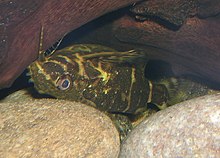| Synodontis nigriventris | |
|---|---|

| |
| Conservation status | |
 Least Concern (IUCN 3.1) | |
| Scientific classification | |
| Domain: | Eukaryota |
| Kingdom: | Animalia |
| Phylum: | Chordata |
| Class: | Actinopterygii |
| Order: | Siluriformes |
| Family: | Mochokidae |
| Genus: | Synodontis |
| Species: | S. nigriventris |
| Binomial name | |
| Synodontis nigriventris David, 1936 | |
Synodontis nigriventris, the blotched upside-down catfish, is a species of upside-down catfish native to the Congo Basin of Cameroon, the Democratic Republic of the Congo and the Republic of the Congo.
Appearance and anatomy
Blotched upside-down catfish are small, reaching a maximum of 9.6 centimetres (3.8 in) SL. Like other members of the family Mochokidae, they have large eyes, a large dorsal fin and three pair of barbels. These fish are adapted to spend most of their time upside-down. This is reflected in the fish's pigmentation – their bellies are darker than their backs, a form of countershading. These fish have lighter colors on the top of their bodies and darker colors below used for camouflage. The lighter colors on the top of them make it harder for predators to see the fish when looking up toward the sky but only when the fish are swimming upside-down.
Ecology and behaviour
Synodontis nigriventris are mostly nocturnal, and feed on insects, crustaceans, and plant matter. These fish lay eggs. The young fish do not swim upside-down until they are about two months old. Adults swim and rest upside down in the water. They swim faster when upside down, and are more likely to be upside down around objects or at the water bottom. The more objects around the fish, the more they tend to swim upside down. When close to an object, the fish puts its ventral side closest to the object. It rarely swims in the middle of the water, preferring to swim either at the bottom or at the surface. By swimming upside down when it feeds, it can readily catch prey at the surface from beneath.
In the aquarium
The blotched upside-down catfish is well suited to aquariums because of its small size (typically 9 or 10 cm or less) and peaceful demeanor.
See also
References
- Moelants, T. (2010). "Synodontis nigriventris". IUCN Red List of Threatened Species. 2010: e.T182250A7842677. doi:10.2305/IUCN.UK.2010-3.RLTS.T182250A7842677.en. Retrieved 20 November 2021.
- ^ Froese, Rainer; Pauly, Daniel (eds.). "Synodontis nigriventris". FishBase. December 2011 version.
- ^ Axelrod, Herbert R. (1996). Exotic Tropical Fishes. T.F.H. Publications. ISBN 0-87666-543-1.
- ^ Ken Ohnishi; Akihisha Takahashi; Hiroaki Tanaka & Takeo Ohnishi (1996). "Relationship between frequency of upside-down posture and space size around upside-down catfish, Synodontis nigriventris". Biological Sciences in Space. 10 (4): 247–251. doi:10.2187/bss.10.247. PMID 11540345.
- Sanford, Gina (1999). Aquarium Owner's Guide. New York: DK Publishing. ISBN 0-7894-4614-6.
- D. L. Meyer; C. Platt & H.-J. Distel (1976). "Postural control mechanisms in the upside-down catfish (Synodontis nigriventris)". Journal of Comparative Physiology. 110 (3): 323–331. doi:10.1007/BF00659148.
- Robert W. Blake & Keith H. S. Chan (2007). "Swimming in the upside down catfish Synodontis nigriventris: it matters which way is up". Journal of Experimental Biology. 210 (17): 2979–2989. doi:10.1242/jeb.006437.
External links
![]() Data related to Synodontis nigriventris at Wikispecies
Data related to Synodontis nigriventris at Wikispecies